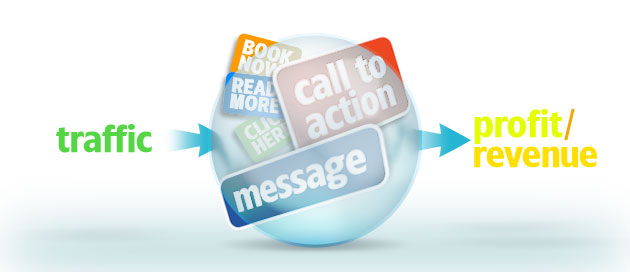One of the first steps in starting your own online business is making a website. This website is your place of business and must be treated as such. Your potential customers will visit your site and decide within seconds if they will stay or go. Turning these fast movers into buyers is one of the major obstacles in building your new business.
Below are 10 things you can do to increase your website’s conversion rate:
Call to Action – Telling your visitors what to do can help turn their indecisiveness into action. Tell them what to do to begin the ordering process. Tell them why they should buy from you and that they should “Buy Now”. Tell them to Click Here to make the purchase. Give clear and concise instructions.
Easy Navigation – Do not make your site a maze for your visitors to try and navigate. Have a simple, clean design with an easy navigational menu. Use short, straightforward, easy-to-read paragraphs. Make all your pages uniform and professional.
Be Direct – Write your page copy like you would talk to your customer. There is no need for fancy words. You do need to be professional but your web pages DON’T need to be written like a complicated legal contract.
Contact Info – Always have your name and contact info on every one of your web pages. Be sure to write an About Us page. People will NOT trust you if they do not know who you are. Make up a Privacy Policy page so your visitors feel secure, which will add to that trust.
Professional Graphics – Graphics can assist in increasing sales but do not use the childish looking cartoon clipart. Use professional well-designed graphics. There are some sites where the cartoon clipart will fit but most will need sharp clean professional graphics.
Easy Ordering Process – One way to lose a customer is by having a long, drawn-out ordering process. Having to click through too many pages to order will have your potential customer clicking to another site. Be sure your shopping cart is secure and doesn’t ask your customer to write a book or click to the moon!
Upfront with Prices – One thing that makes me leave a site very quickly is if they try to hide their prices. Even if your prices are a bit high, you will be better off to be upfront with them than to try and hide them. Also, have easy access to your shipping rates and return policies.
A sense of Urgency – Sometimes people need a little help deciding if they should order or not. Creating a sense of urgency can help them make that decision. Limited Time Offer, Limited Supply, First 10 Customers, Buy Now for Free Gift. All these types of phrases help get the customer in the “Buy Now” frame of mind.
Stress the Benefits – Be sure to explain what your products and/or services can do for your customer. Benefits sell more than features. For example: If you are selling office chairs, be sure to tell them how it will help their posture thus minimizing back pain instead of explaining what the chair is made from. Let them feel it and know the chair will support their spine rather than going on and on about the fabric. People want to know what your product can do for them!
Make Your Visitors Feel Good and Appreciated – If your visitors feel good and appreciated just for being a visitor, then they know they will be treated well as a customer. Give a free gift just for stopping by. Give them a discount on their first order. Let them know you appreciate them and thank them for even stopping by your site.
All these things can help sway a person’s decision “To Buy or Not to Buy”. Try as many as you can and see how effective they can be.
Please feel free to send us your comments and keep in touch with me and my team.
Like/Share this blog post as much as possible.
Thanks a million for helping to spread this information.




